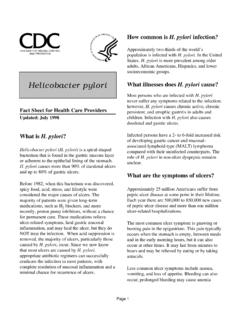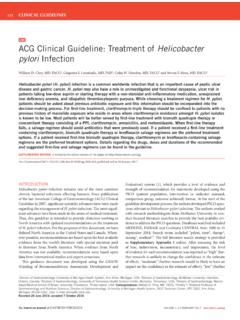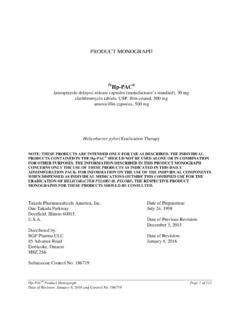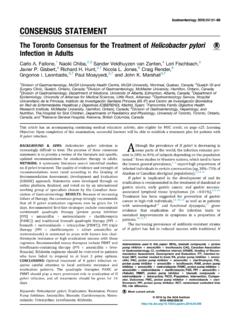Transcription of New Zealand Data Sheet Pantoprazole Actavis - Medsafe
1 New Zealand data Sheet Pantoprazole Actavis Pantoprazole Sodium Sesquihydrate, enteric coated tablets, 20 mg and 40 mg (as Pantoprazole ) Presentation 20 mg: Light yellow, elliptical, gastro-resistant film coated tablets, approximately by mm, plain on both sides. Each tablet contains Pantoprazole Sodium Sesquihydrate mg equivalent to Pantoprazole 20 mg. 40 mg: Dark yellow, elliptical, gastro-resistant film coated tablets, approximately by mm, plain on both sides. Each tablet contains Pantoprazole Sodium Sesquihydrate mg equivalent to Pantoprazole 40 mg. Uses Actions Pharmacotherapeutic group A02BC02 Proton pump inhibitors. Mechanism of action Pantoprazole is a substituted benzimidazole which inhibits the secretion of hydrochloric acid in the stomach by specific action on the proton pumps of the parietal cells.
2 Pharmacodynamic effects Pantoprazole is converted to its active form in the acidic canaliculi of the parietal cells when it inhibits the H+, K+-ATPase enzyme, the final stage in the production of hydrochloric acid in the stomach. The inhibition is dose-dependent and affects both basal and stimulated acid secretion. Onset and duration of action In most patients, freedom from symptoms is achieved in 2 weeks. As with other proton pump inhibitors and H2 receptor antagonists, treatment with Pantoprazole causes a reduced acidity in the stomach and thereby an increase in gastrin in proportion to the reduction in acidity. The increase in gastrin is reversible. Since Pantoprazole binds to the enzyme distal to the cell receptor level, the substance can affect hydrochloric acid secretion independently of stimulation by other substances ( acetylcholine, histamine, gastrin).
3 The effect is the same whether the product is given orally or intravenously. The fasting gastrin values increase under Pantoprazole . On short-term use, in most cases they do not exceed the normal upper limit. During long-term treatment, gastrin levels double in most cases. An excessive increase, however, occurs in isolated cases. As a result, a mild to moderate increase in the number of specific endocrine (ECL) cells in the stomach is observed in a minority of cases during long-term treatment (simple to adenomatoid hyperplasia). However, according to the studies conducted so far, the formation of carcinoid precursors (atypical hyperplasia) or gastric carcinoids as were found in animal experiments can be ruled out for humans for a one year treatment period. An influence of a long-term treatment with Pantoprazole exceeding one year cannot be completely ruled out on endocrine parameters of the thyroid and liver enzymes according to results in animal studies.
4 Pharmacokinetics Pharmacokinetics do not vary after single or repeated administration. In the dose range of 10 to 80 mg, the plasma kinetics of Pantoprazole are virtually linear after both oral and intravenous administration. Absorption Pantoprazole is rapidly and completely absorbed after oral administration. The maximal plasma concentration is achieved even after a single oral dose. On average at about h to h maximum plasma levels of about 1 to mcg/ml following a 20 mg dose and 2 to 3 mcg/ml following a 40 mg dose are achieved, and these values remain constant after multiple administration. The absolute bioavailability from an oral dose was found to be about 77%. Concomitant intake of food had no influence on AUC, maximum plasma concentration and therefore bioavailability. Only the variability of the lag-time will be increased by concomitant food intake.
5 Distribution The volume of distribution is about l/kg and about 98% is bound to plasma proteins. Biotransformation Pantoprazole is almost exclusively metabolised in the liver. Renal elimination represents the major route of excretion (about 80%) for the metabolites of Pantoprazole , followed by biliary excretion. The main metabolite in both the plasma and urine is the desmethylpantoprazole sulphate conjugate. The half-life of the main metabolite (about h) is not much longer than that of Pantoprazole . Elimination The terminal half-life is about 1 h and the clearance is about l/h/kg. There were a few cases of subjects with delayed elimination. As Pantoprazole specifically binds to the proton pumps of the parietal cell, the elimination half-life does not correlate with the much longer duration of action (inhibition of acid secretion).
6 Special patient groups Renal impairment No dose reduction is necessary when Pantoprazole is administered to patients with restricted kidney function (including dialysis patients). As with healthy subjects, the half-life of Pantoprazole is short. Only very small amounts of Pantoprazole can be dialysed. Although the main metabolite has a moderately delayed half-life (2 to 3 h), excretion is still rapid and thus accumulation does not occur. Liver disease For patients presenting liver cirrhosis (classes A and B according to Child) the half-life values increased, to between 3 to 6 h following a 20 mg dose and 7 to 9 h following a 40 mg dose, and the AUC values increased by a factor of 3 to 5 following a 20 mg dose and between 5 to 7 following a 40 mg dose. However, the maximum plasma concentration only increased slightly, by a factor of following a 20 mg dose and following a 40 mg dose, compared with healthy subjects.
7 Elderly patients A slight increase in AUC and Cmax in elderly volunteers compared with younger counterparts is also not clinically relevant. Indications For the symptomatic improvement and healing of gastrointestinal diseases which require a reduction in acid secretion: duodenal ulcer (DU); gastric ulcer; gastro-oesophageal reflux disease (GORD) - for the treatment of mild reflux disease and associated symptoms ( heartburn, acid regurgitation, pain on swallowing) and reflux oesophagitis; Zollinger-Ellison Syndrome. Eradication of Helicobacter pylori (hereinafter referred to as H. pylori ) in combination with clarithromycin and amoxicillin, or clarithromycin and metronidazole, or amoxicillin and metronidazole, (refer to Dosage and Administration), in cases of duodenal ulcer and gastric ulcer with the objective of reducing the recurrence of duodenal and gastric ulcers caused by this microorganism.
8 The NIH have recommended that regimens to eradicate H. pylori in patients with peptic ulcer disease (PUD) should contain both anti-secretory agents and anti-microbial agents (to which H. pylori has been demonstrated to be sensitive in vivo). A trial by Bardhan in patients with gastritis, florid duodenal ulcer or history of duodenal ulcer, has demonstrated that Pantoprazole 40 mg twice daily in the combination with tinidazole 500 mg twice daily and clarithromycin 250 mg twice daily for 10 days is effective in eradicating H. pylori in 86% of cases. Following combination therapy, the DU healing rate was 100% after 1 month. Prevention of gastroduodenal ulcers induced by non-selective non-steroidal anti-inflammatory drugs (NSAIDs) in patients at risk with a need for continuous NSAID treatment. Maintenance Pantoprazole is indicated for maintenance treatment of reflux oesophagitis, duodenal ulcer, gastric ulcer and Zollinger-Ellison syndrome.
9 Prolonged treatment should be considered: in patients who have recurrent peptic ulceration where the pathogenesis of the ulcer is not related to H. pylori infection; or where repeated eradication therapy is unsuccessful; or who have a past history of perforation or bleeding from an ulcer. Dosage and Administration H. pylori eradication In H. pylori positive patients with gastric and duodenal ulcers, eradication of the germ by a combination therapy should be achieved. One of the following combinations of Pantoprazole with antibiotics is effective: Pantoprazole 40 mg twice daily plus amoxicillin 1000 mg twice daily plus clarithromycin 500 mg twice daily; Pantoprazole 40 mg twice daily plus metronidazole 500 mg twice daily plus clarithromycin 500 mg twice daily; Pantoprazole 40 mg twice daily plus amoxicillin 1000 mg twice daily plus metronidazole 500 mg twice daily.
10 In the case of combination therapy the datasheets of the respective drugs should be observed. Combination therapy involving metronidazole must only be used if the other combination partners are contraindicated, since damage to human germ cells by metronidazole cannot be excluded and animal studies revealed an increased incidence of certain tumours. General instructions For eradication of H. pylori , convenient dosing could be at breakfast and dinner times. The combination therapy is implemented for 7 days. If, to ensure healing of the ulcers, further treatment with Pantoprazole is indicated, the dosage recommendations for duodenal and gastric ulcers should be considered. If combination therapy is not an option, if the patient has tested negative for H. pylori , the following dosage guidelines apply for Pantoprazole monotherapy: Duodenal ulcer The recommended oral dosage is Pantoprazole 40 mg per day.
















